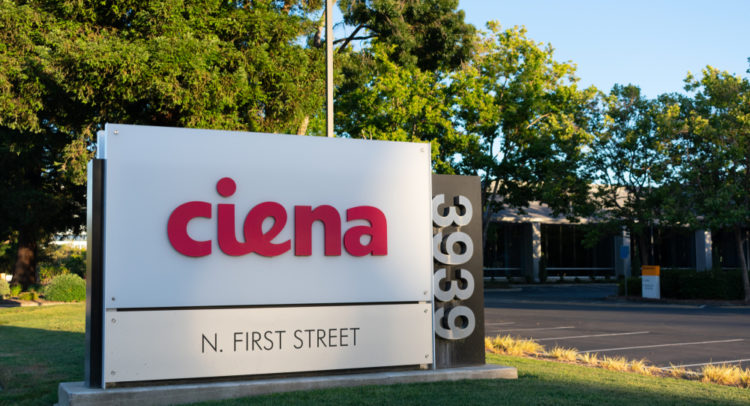It has been a rough period for optical suppliers, as reduced spending from telco service providers like AT&T (T) and Verizon (VZ) has led to weaker demand for Ciena (CIEN), as well as peers and rivals like Cisco (CSCO), Infinera (INFN), and Juniper (JNPR).
Confident Investing Starts Here:
- Easily unpack a company's performance with TipRanks' new KPI Data for smart investment decisions
- Receive undervalued, market resilient stocks right to your inbox with TipRanks' Smart Value Newsletter
That said, Ciena has likely seen the worst of this cyclical slowdown, as book-to-bill has climbed back above 1.0 and orders should translate to stronger revenue in the second half of the year. Beyond the near-term recovery, there are also opportunities for Ciena to displace Huawei with European and Asian customers and gain market share in new metro/edge applications.
Bearing this in mind, Ciena should trade closer to $62 today, with longer-term annual return potential in the high single-digits to low double-digits as the company executes on market expansion opportunities.
Better Fiscal Q1 Results, But Not Meaningfully So
Ciena posted fiscal first quarter results that were ahead of Street expectations, but the significance of the outperformance is low. Revenue declined 9% year-over-year and almost 9% quarter-over-quarter (to $757 million), beating expectations by 1%, while gross margin landed in-line with expectations at 48% (up about three basis points year-over-year). Operating income rose 2% year-over-year and operating margin of 14.6% (up 150 basis points) was two points better than expected. However, with the company pushing some expenses out into the second quarter, it doesn’t net out to any meaningful change in outlook.
It was a tough quarter overall. Like Infinera, Ciena saw better results in the international segment. That said, this was the weakest quarter for the North American business since the first quarter of 2019.
Service provider revenue fell 15% year-over-year, while cable provider revenue fell 35% year-over-year, and that’s a difficult headwind to overcome. Webscale performance was also soft. The business grew 25% year-over-year against a weak comp, but declined 14% quarter-over-quarter, and management only guided for mid-single-digit growth for the year.
As far as bright spots go, though, cable provider revenue did improve more than 12% quarter-over-quarter. Additionally, the book-to-bill did turn positive for the first time in a year, and management continues to expect stronger 800G deployments in the second half of the year. The company also continues to see strong interest for its WaveLogic 5 Extreme, with initial customer adds running double the rate of the prior WaveLogic Ai.
Growth Opportunities Beyond 2021
One of the most attractive parts of the Ciena story is the company’s opportunity to displace Huawei in the service provider market, as multiple countries in Europe and Asia have banned further use of Huawei’s optical equipment.
Ciena has historically underperformed in Europe (10% share against global share excluding China of 30%), and taking a meaningful part of Huawei’s legacy 35% share in Europe is a major growth opportunity. Nokia (NOK) will fight hard for that business too, but it has had some serious product development/performance issues and has had to compete largely on the basis of price in recent years – something that has become increasingly difficult to maintain.
Beyond the Huawei opportunity (which also extends to non-European markets like India), the edge/metro application market is substantial. It is becoming too cumbersome to place routers everywhere they would traditionally go, and Ciena has developed solutions that bring together optics and IP functionality (along with software automation) and offer an elegant solution to this problem. This could increase the addressable market from around $3 billion today to around $4.5 billion in 2024.
The Outlook
There are multiple threats to Ciena’s outlook. Nokia could prove to be more successful than Ciena in displacing Huawaei, and Ciena faces meaningful competition in the enterprise market from Cisco and Inphi (IPHI). That said, the WaveLogic 5 Nano should offset some of Inphi’s momentum with its new upcoming ZR product. In terms of other risks, service provider spending could be slower to rebound, particularly after huge industry-wide expenditures on spectrum, but equipment spending has to come at some point (or the spectrum does them no good).
Full-year revenue growth will likely be quite modest in fiscal ’21 at around 1.5% (versus guidance of 0%-3%), but growth should accelerate to over 9% in FY’22 and stay above-trend through FY’24. In the long-term, revenue growth could be around 5%, with free cash flow margins in the low-to-mid teens, driving high single-digit long-term annualized free cash flow growth.
Analysts Weigh In
Looking at the consensus breakdown, 10 Buys and 2 Holds have been assigned in the last three months. So, CIEN is a Strong Buy. At $59.17, the average analyst price target implies 7% upside potential. (See Ciena stock analysis on TipRanks)

The Bottom Line
Based on discounted cash flow and a margin-driven EV/EBITDA valuation approach, Ciena could trade in the low $60’s near-term, with longer-term total annualized appreciation potential in the high single-digits to low double-digits. Given the upcoming recovery in revenue and a still-underappreciated opportunity to gain share in Europe and expand into new markets, Ciena is an attractively-priced stock today.
Disclosure: At the time of publication, Stephen Simpson owned shares of CIEN.
Disclaimer: The information contained herein is for informational purposes only. Nothing in this article should be taken as a solicitation to purchase or sell securities.
Looking for a trading platform? Check out TipRanks' Best Online Brokers , and find the ideal broker for your trades.
Report an Issue








